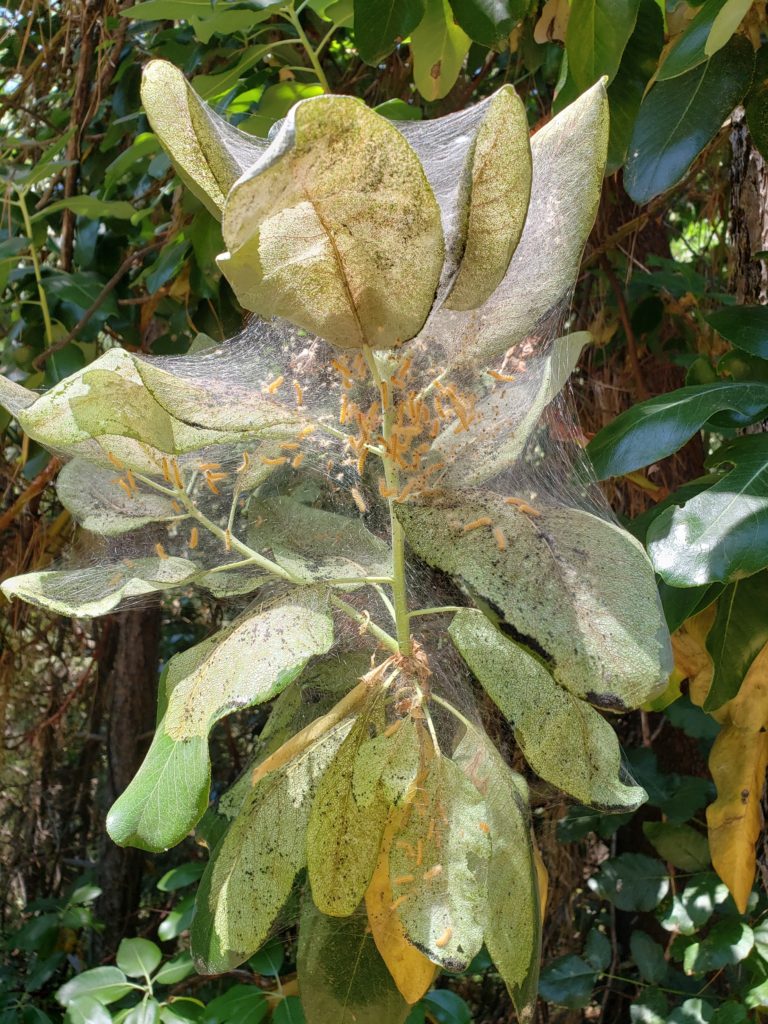Those are fall webworms (Hyphantria cunea), native to North America from southern Canada down to northern Mexico. They are perfectly normal and a part of our ecosystems across the continent.
They thrive in the warmest time of the year, starting their webs in around July and continue into fall. What makes the webs are the caterpillars, or larvae, of the fall webworm moth, a pretty little white moth with a furry white body. Some moths may have black or brown spots or stripes on their wings.
You will most likely see the adults in the early summer during their egg laying time. What we see starting in July and into the fall is the larvae and their protective webs. It starts with a cream colored body with a red head and lives and grows in the web munching on leaves.
Have you not noticed them before?
Well, that’s part of the normal ebb and flow of their populations. I see that there are more this year than the last several years. They grow in numbers for a couple of years before returning back to normal for several years.
So while it’s scary to see more than you can remember, and you may fear we’re headed for disaster, most likely we’re not.
Do they harm the trees?

No, they usually don’t harm the trees. So you usually don’t need to take any action.
The webworm eggs hatch and start eating the surface layer of leaves. They collectively build a web around themselves to protect them against their predators, of which they have many. As the larvae grow, their webs increase in size. And they eat further into the layers of the leaves.
The leaves do eventually die from all the munching but what saves the tree is that most of the damage occurs when photosynthesis is slowed down for the season. The munching does not affect the normal formation and growth of next year’s buds.
Their predators are around
There are upwards of 60 species of predators of the webworm, including birds, some small mammals, spiders, predaceous insects, many species of small parasitic wasps. Parasitic wasps amaze me because, they get into the web and lay their eggs into the body of the caterpillar. The eggs hatch and those larvae feed off the webworm larva and emerge as adults, killing the webworm in the process.
One reason for the fluctuation of the webworm population is that the moth population grows when there are fewer parasitic insects available to feed on them. But as the webworm population increases each year, so do the predators until there’s a more even match. That’s enough to knock down the population of the webworm so we go back to normal populations for several years.
Which trees do they eat?
Many insects need specific plant leaves to eat and some can eat a wide variety of species; they’re either specialists or generalists. The fall webworm is a generalist. Around here we see a lot of webs in madrones, but also in northern California black walnut, apple trees, and several other hardwood trees and shrubs. While they eat many different species, they tend to favor just a few in any given area.
Look up fall webworm on Calscape.org in the butterflies category. You’ll find the huge list of our native plants that they may feed on. But we mostly only see them on the above mentioned trees.
Nationwide they can feed on up tp 900 species of plants. Including apples, where the growing fruits may be trapped in the webs and get nibbled, too.
They may be munching on your favorite apple tree
While most trees are not harmed by fall webworms, a small ornamental or fruit tree can occasionally be so full of webs that you just can’t stand the looks of it, and you really feel you need to do something to preserve your sanity.
There are a few things you can do. I’ll start with the simplest method.
As I mentioned above, the webworms have a lot of predators. But the best defense the webworms have is their thick webs. The first step for us is to simply poke and open the webs to allow the predators quicker and easier access to the larvae. This can be done with a pole or a jet spray of water.
You can cut out and remove the branch with the web and dispose of it. But this can ruin the shape of your plant, so it’s not the best option.
If you feel you need more immediate relief, the next step is to poke the web open and spray with Bt, Bacillus thuringiensis, an organic, environmentally friendly way to stop caterpillar problems. It is a bacteria that affects only caterpillars. But not doing this allows the population of predatory insects to proliferate to meet the abundance of prey.
There are systemic pesticides and other pesticide sprays that would kill them but they would kill the predators, too. And get into the birds, and quite possibly into you. This caterpillar is not such a dangerous pest to warrant extreme eradication measures.
At least not in North America.
Is it a pest?
When an insect is a generalist in its eating habits, it can easily become a pest when it’s out of its native territory. That’s because it doesn’t have its natural enemies keeping its populations in line with natural checks and balances.
The fall webworm has been accidentally imported into parts of Europe and Asia where it has taken hold and done real damage to the forests there. It’s like what the gypsy moth has done to North American forests.
But here in North America it doesn’t amount to any real or severe damage.
They’re pretty social
I always like to know more interesting things about the plants and animals around us. They never cease to amaze me. A fun thing I’ve learned about these webworms is that they display a bit of social behavior.
It’s a joint project to build and maintain the web to preserve their safety. When an intruder tries to break in, when young, the nearest webworm caterpillar will lift and sway the front part of its body to and fro scraping along the leaf it’s on to make a brushing sound. This gets all the others to follow along and together they can make a significant scary noise to shoo the predator away.
It seems to be a constant balance between the art of predation and the art of defense.
When they leave the web they travel down the trunk to pupate in the soil below, in bark crevices, or under rocks. The travel and pupation leaves them more vulnerable to predation.
The process of feeding the ecosystem
Food for birds, parasitic wasps and other predaceous animals, and the caterpillars are doing damage to leaves that have done most of the photosynthesis work for the season. Fall webworms are animals that are turning foliage into protein that supplies other animals in the ecosystem.
So what we think of as ugly webs is really part of the base of the food chain that keeps our ecosystem healthy. So are they ugly? Watch the process and enjoy it for what it’s all about.

